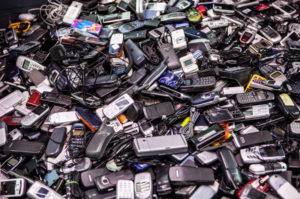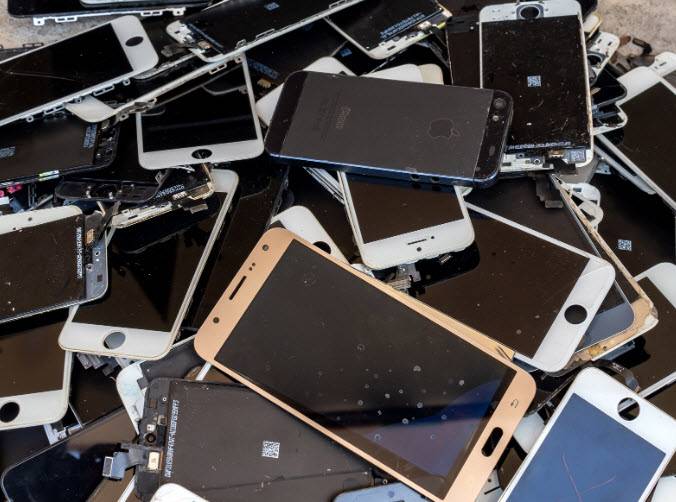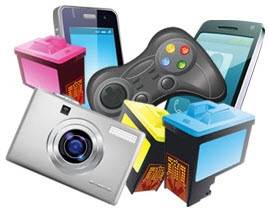1. The Electronic Menace: Why E-waste is a Major Concern Today
 The world today is in the midst of a rapidly expanding wave of digitization. As technology evolves and continues to automate functions across industries, countries across geographies have witnessed visible growth in the use of electronic devices across every sector. In light of this situation, India has emerged as a prime example of a country that has successfully harnessed the complete advantages of digital technology. While progress has been made in all sectors, however, the country today must also be aware of another type of growth that has been taking place simultaneously: the rise in numbers of redundant or unused electronic devices that lead to the creation of ‘e-waste problem’.
The world today is in the midst of a rapidly expanding wave of digitization. As technology evolves and continues to automate functions across industries, countries across geographies have witnessed visible growth in the use of electronic devices across every sector. In light of this situation, India has emerged as a prime example of a country that has successfully harnessed the complete advantages of digital technology. While progress has been made in all sectors, however, the country today must also be aware of another type of growth that has been taking place simultaneously: the rise in numbers of redundant or unused electronic devices that lead to the creation of ‘e-waste problem’.
E-waste in India
According to a joint study by Assocham and KPMG, India ranks as the 5th largest producer of e-waste in the world, discarding roughly 18.5 lakh metric tonnes of electronic waste each year. Most of this e-waste is generated by the telecom sector, a direct outcome of the focus donated to it in the 1990s as part of the telecom revolution that hastened India’s progress towards digitization. This progress has only increased in momentum over time, concurrently increasing the rate at which technology, and hence devices, have become redundant. While 70per cent of the discarded devices is in the form of computers, mobile phones also make significant contributions to the generation of e-waste in the country. Assocham has also found that most Indians prefer to switch to new mobile devices every two years, thereby validating the above-stated contribution by the telecom sector. This fact, combined with the country’s electronics import bill that currently stands at $57 billion, clearly indicates that an excess of discarded electronics goods is a contemporary issue to be addressed.
Lack of Proper Means of E-waste Disposal
Given the extensive nature of this issue, governments across the world have adopted a dual strategy to ensure proper e-waste management: firstly, public e-waste legislation that details the protocol to be followed for disposal have been established by 66per cent of governments across the world. The second strategic aspect involves concerted efforts towards raising public awareness about the hazards of e-waste. Both these strategies have, however, been met only with mild success. Currently, only 20per cent of global e-waste is recycled properly, with the number dropping to 1.5per cent in the Indian context. Comparatively, the government and private organizations have been major culprits in e-waste generation, with three-fourths of all of India’s e-waste production being routed back to them. Conversely, e-waste disposal is mainly handled by the unorganized sector in the country; a sector that comprises a population that cannot differentiate between overall waste and e-waste due to the previously stated lack of public knowledge.
Health Hazards of E-waste
Similar to other forms of pollution, e-waste too, mainly causes problems in two domains: health and the environment. E-waste such as computers, mobile phones, televisions, and other devices contain minute amounts of a variety of metals (such as gold, silver, copper, and tin) that can be reused if extracted efficiently during the disposal process. The unorganized sector, however, is inadequately trained in facilitating this process, choosing instead to merely dispose of e-waste in large landfills along with other waste. As a result, most of these salvageable materials leak into the soil, contaminating large tracts of lands and making them unfit for cultivation. Additionally, metals such as mercury, cadmium, and lead, which are commonly found in device circuit boards, may leach into groundwater, causing debilitating health issues such as damage to the brain, liver, kidneys, lungs, nervous system and bones. As the population most in contact with these metals, the unorganized sector bears the major brunt of these problems. Households too are not immune to this phenomenon. Similar to leakages found in batteries, unused electrical devices slowly release toxic chemicals over time that pose similar health hazards within the space where they are stored.
Article source: entrepreneur.com
2. What Can We Do About the Growing E-waste Problems?
 Why the upsurge in e-waste?
Why the upsurge in e-waste?
Technology is becoming more and more integrated into every aspect of our lives. Semiconductors and sensors are being added to products that never before had them, creating wearable monitors, smart homes, TVs that can stream programming from the internet, and much more.
Meanwhile, the life span of devices is getting shorter—many products will be thrown away once their batteries die, to be replaced with new devices. Companies intentionally plan the obsolescence of their goods by updating the design or software and discontinuing support for older models, so that now it is usually cheaper and easier to buy a new product than to repair an old one. Meanwhile, the companies continue to profit from steady sales.
And because prices are dropping, electronic devices are in demand around the world as a growing middle class goes digital. Globally, half of all households now have internet access, and 7.7 billion people have cell phones.
What’s in e-waste?
Electronic devices are made of a complex mix of materials that include gold, silver, copper, platinum, palladium, lithium, cobalt and other valuable elements. The U.S. Environmental Protection Agency (EPA) says, “One metric ton of circuit boards can contain 40 to 800 times the amount of gold and 30 to 40 times the amount of copper mined from one metric ton of ore in the United States.” These precious materials can be reclaimed through recycling.
But electronic devices also comprise toxic heavy metals like lead, mercury, cadmium and beryllium, polluting PVC plastic, and hazardous chemicals, such as brominated flame retardants, which can harm human health and the environment.
In 2016, the estimated value of recoverable materials in global e-waste was $64.6 billion, but only 20 percent of it was properly recycled to enable recovery of the valuable materials. Much of the rest is dumped in landfills where toxic chemicals can leach from the e-waste and end up contaminating the water supply.
As more people buy electronic equipment, manufacturers are beginning to face shortages of the raw materials needed to make their products, so reclaiming and reusing the materials from discarded products and waste—a process called urban mining—makes economic and environmental sense. A recent study in China found that mining copper, gold and aluminum from ore costs 13 times more than recovering the metals through the urban mining of e-waste.
The state of e-waste recycling
Recycling e-waste is practiced both formally and informally.
Proper or formal e-waste recycling usually involves disassembling the electronics, separating and categorizing the contents by material and cleaning them.
Items are then shredded mechanically for further sorting with advanced separation technologies. Companies must adhere to health and safety rules and use pollution-control technologies that reduce the health and environmental hazards of handling e-waste. All this makes formal recycling expensive. As a result, many companies and countries illegally export their e-waste to developing countries where recycling is cheap.
The U.S., the second largest producer of e-waste after China, produced 10 million tons of e-waste in 2012, over 64 pounds per person. In 2012 (EPA data for more recent years are not yet available), only 29 percent of this was recycled—the rest is usually landfilled, incinerated or stuck in a closet. A study was done by the watchdog group Basel Action Network using trackers, however, found that 40 percent of the e-waste supposedly recycled in the U.S. was actually exported. Most of it ended up in developing countries—usually in Asia—where informal recycling is typically unlicensed and unregulated.
Criminals search e-waste for credit card numbers and other financial information. For example, government contracts and lucrative agreements with the U.S. Defense Intelligence Agency, the Transportation Security Administration and Homeland Security have been found on hard drives in Agbogbloshie, an e-waste center in Ghana.
Wealthy countries send about 23 percent of their e-waste to developing countries each year. This is ongoing despite the fact that the European Union and 186 states have ratified the Basel Convention, which works to minimize the transfer of hazardous waste from developed countries to developing countries. The U.S, the only developed country that has not ratified the Basel Convention, has agreements that allow it to ship hazardous waste to developing countries.
What U.S. laws govern e-waste?
There is no federal law in the U.S. that mandates the recycling of e-waste or forbids e-waste from being exported to developing countries. Twenty-eight states and the District of Columbia have their own electronic recycling laws, which vary in approach. Some states subcontract with companies to operate a statewide collection system; others require manufacturers to meet minimum recycling targets based on their sales.
The problem with a patchwork of laws is that no one state has enough market share to compel manufacturers to design greener or more durable products. By contrast, the European Union’s Restriction of Hazardous Substances Directive represents the entire EU market and thus has the clout to set higher standards for all electronic products sold in the EU. Its laws requiring manufacturers to help pay for recycling have resulted in an e-waste recycling rate of 35 percent, higher than that of the U.S.
A problem requiring multiple solutions
With the flood of e-waste growing around the world, recycling alone will not be enough. Here are some other ideas and solutions that are being researched, considered or practiced around the world. Hopefully, they will inspire more adoption of best practices.
Designing better products
In order to reduce e-waste, manufacturers need to design electronics that are safer, and more durable, repairable and recyclable. Most importantly, this means using less toxic materials. Chemical engineers at Stanford University are developing the first fully biodegradable electronic circuit using natural dyes that dissolve in acid with a pH 100 times weaker than vinegar. One group of scientists is pulverizing e-waste into nanodust by cooling the various materials, then grinding them up into homogenous powders that are “easy to reuse.” Canada-based Ronin8 has developed a technology that uses minimal water and energy as it separates metals from non-metals through sonic vibrations in recycled water.
Today, it’s not a priority to design goods that can be reused or remanufactured, though for a few years, companies experimented with modular phones that enabled consumers to upgrade parts of their phones instead of having to entirely replace them.
The right to repair
In addition to recycling, it’s also important to be able to repair and reuse the devices we have. But even if you know how to and want to repair your electronic device, you might be stymied because your product’s software is subject to copyright. The copyright often forbids consumers by law to tinker with or reverse-engineer the device or use an unauthorized repairer. Ifixit.org demands the right to repair devices and teaches people how to do it.
Extended Producer Responsibility
Extended producer responsibility requires companies that make products to be responsible for the management and disposal of them at the end of their lives. The idea is to turn waste materials into a resource for producing new products. The New York State Electronic Equipment Recycling and Reuse Act requires manufacturers to provide consumers with free and convenient e-waste recycling.
What you can do about e-waste
The best thing you can do is to resist buying a new device until you really need it. Try to get your old product repaired if possible and if it can’t be fixed, resell or recycle it responsibly.
Before you recycle your device, seal up any broken parts in separate containers so that hazardous chemicals don’t leak. Wear latex gloves and a mask if you’re handling something that’s broken.
Article source: blogs.ei.columbia.edu
3. E-Waste Problems Are Ridiculous, and Gadget Makers Aren't Helping
 Device upgrades have become increasingly frequent for many of us. Unfortunately, too many people give virtually no thought to what becomes of all these discarded gadgets.
Device upgrades have become increasingly frequent for many of us. Unfortunately, too many people give virtually no thought to what becomes of all these discarded gadgets.
And neither are most device manufacturers.
Some 41.5 million tons of electronic waste was generated in 2011, and that number is expected to rise to 93.5 million by 2016, according to the research firm Markets and Markets. Right now, 70 to 80 percent of all that old gadgetry goes straight to landfills which helps to increase e-waste problem.
Oh sure, many companies have green initiatives. Apple, in particular, has made notable, documented efforts to reduce its carbon footprint, powering a majority of its retail stores and data centers with renewable energy, developing more efficient packaging design, and designing products that use less power than their predecessors. But if your products are going to be tossed out in a year, none of that is particularly brag-worthy. That's a tremendous amount of wasted resources.
In the past, computers were designed to be relatively easy to disassemble, like HP's towers and older versions of the Mac Mini. You could swap out dead parts and batteries, add more memory if it got sluggish, even replace a motherboard. But in the mid-2000s, things started to change. Apple introduced the ultra-thin, ultra-light MacBook Air and the industry enthusiastically followed with heaping helpings of devices that, while slim, were very difficult to repair due to the construction compromises required to achieve that svelte profile. Smartphones and tablets followed with an even faster purchasing and chucking cycle.
As mobile gadgets exploded we became a culture that abandoned its gear regularly, on a massive scale. It’s an epic environmental and economic problem not simply because people aren't properly recycling their old devices, but because many devices are all but impossible to recycle efficiently and thus creates e-waste problem.
Electronics include a host of environmentally deleterious chemicals like mercury, cadmium, lead, phosphors, arsenic, and beryllium. When they end up in a landfill, these chemicals eventually seep into the ground and into our water supply. Thus, properly disposing of them through programs offered by device manufacturers like Asus, Samsung, or Apple, or retailers like Best Buy or Staples, are paramount.
But that's only part of the equation. Manufacturers also play a vital role in the success (or failure) of this endeavor.
The Recycling Process
When you turn your device in to get recycled, a few things happen. First, it’s assessed. Does it have dents or scratches? A broken screen? Does it turn on? If it’s in good shape, the product is wiped of any remaining data and repackaged to be resold. This is generally done by hand.
“You can mechanize the cleaning, but the assessment, fixing, re-testing, and repackaging is still a very human and touch-related business,” said John Shegerian, the CEO of ERI. The company is among the world's largest e-waste recyclers, with more than one billion pounds of of material recycled since 2005.
If a product’s not fit to resell or the manufacturer isn't interested in selling refurbished gadgets, it is disassembled and shredded so things like steel, copper, and aluminum can be recycled. Glass is also melted down and recycled. When you send your device to a recycling outfit like ERI, nothing ends up in the landfill. But for such an effort to be worthwhile, two things must be considered: What's the value of the raw materials that can be recovered from the device, and how much effort does it take to get them? If retrieving all that material costs more than it's worth, it simply isn't worth the effort because the recycler is operating at a loss.
Therefore, the easier it is to disassemble something, the more likely it is to be worth someone's time to recycle it. And that’s where issues arise.
Recycling Challenges
“The big problem the electronics industry is facing as a whole is products are getting lighter and lighter,” iFixit’s Kyle Wiens said. “This is great for consumers but a nightmare for recyclers.” Smaller, lighter products can be tricky to take apart, and yield a lower volume of raw materials.
Safety is a big concern for the workers tasked with dismantling discarded gadgetry. iFixit, which tears down electronic devices and posts online repair manuals, often works with recycler to ensure everything is safely and efficiently disassembled. Device manufacturers usually don’t do that.
Designing Recyclable Products
While no one we spoke with would say so outright, Apple products are among the most difficult to recycle. (Apple did not respond to repeated requests for comment.) The very things that make them the most marketable—multiple colors, thin profile, big glass displays, seamless cases—also make them difficult to disassemble. However, Sims, the company Apple officially contracts with for recycling, suggested that Apple works with them to develop and provide tools workers can use and is very engaged in helping them figure out the best way to recycle products at the end of their useful lives.
Not all device makers, and not all recycling facilities, get this same level of help though. Sometimes, between the time it takes to dismantle products and the injuries workers get in the process, lucrative contracts with specific manufacturers are barely worth the trouble.
Article source: wired.com

